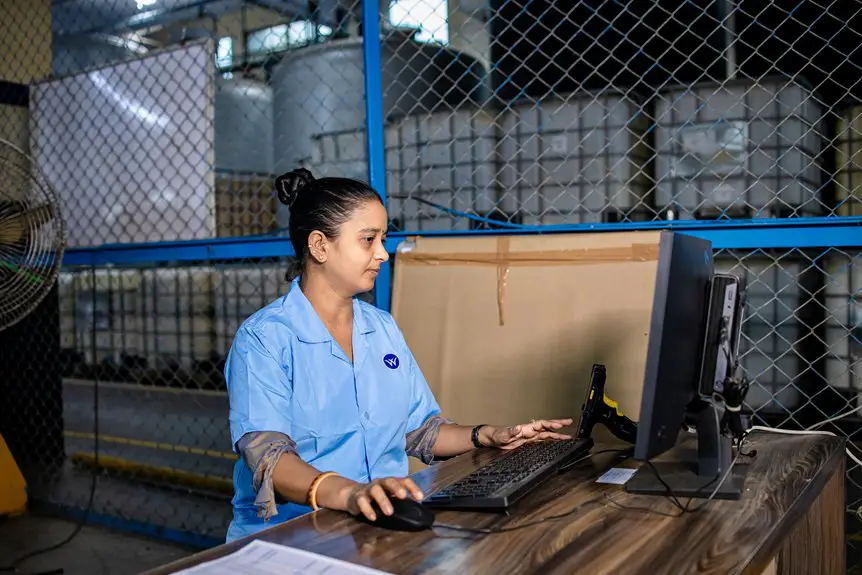To manage multiple webcams on one computer, make sure you have enough USB ports and consider using a powered hub for extra connections. Check your computer's specifications and compatibility with the webcams and chosen software. Install and test the software to ensure it supports multiple inputs. Adjust video settings for optimal quality, and don't forget to troubleshoot any connection issues by checking USB bandwidth and camera recognition. There's much more to explore about enhancing your setup.
Table of Contents
Key Takeaways
- Ensure your computer has sufficient USB ports or use a powered USB hub to connect multiple webcams effectively.
- Choose compatible software that supports multiple camera inputs and meets your system requirements to avoid performance issues.
- Test each webcam individually for functionality and adjust settings like resolution and frame rate for optimal video quality.
- Regularly check camera connections and designate specific roles for each camera angle to enhance production quality during live events.
- Monitor system resources and update drivers to prevent lag or crashes while managing multiple webcam streams.
Understanding the Basics of Webcam Connectivity
Webcam connectivity is crucial for anyone looking to manage multiple cameras effectively.
You'll need to ensure that your computer has enough USB ports to accommodate all the webcams you plan to use. If you're running low on ports, consider using a powered USB hub, which can expand your connectivity options.
Check your computer's specifications to confirm it can handle the bandwidth required for multiple streams without lag. Additionally, make sure your webcams are compatible with your operating system and any software you might use.
When setting up, test each camera individually to confirm they're working correctly.
Good connectivity not only improves your experience but also enhances the quality of your streams, making it easier to manage everything seamlessly.
Choosing the Right Software for Multiple Webcam Management
When managing multiple webcams, choosing the right software is crucial for seamless operation.
You'll want to consider software compatibility with your devices and the features that allow for easy video switching.
Finding the right balance can enhance your overall streaming experience significantly.
Software Compatibility Considerations
Choosing the right software for managing multiple webcams can significantly enhance your streaming or recording experience.
First, ensure the software you pick supports all the webcams you plan to use; not every application is compatible with every camera. Look for software that offers seamless integration with both USB and network cameras.
Additionally, check the system requirements to confirm your computer can handle the software without lagging. Don't forget to consider the software's ability to work with your preferred operating system, whether it's Windows, macOS, or Linux.
Finally, read user reviews to gauge reliability and ease of use. Finding compatible software will help you maximize your webcam setup and ensure smooth operation during your projects.
Features for Video Switching
To ensure a smooth and engaging experience while managing multiple webcams, it's essential to prioritize features that facilitate efficient video switching.
The right software can make all the difference in your presentations, streams, or meetings.
Here are three key features you should look for:
- Instant Switching: You want software that allows you to switch between webcams seamlessly, keeping your audience engaged without awkward pauses.
- Customizable Layouts: Having the ability to create different layouts can enhance your content's visual appeal, making it more dynamic and interesting.
- Audio Management: Effective audio control is crucial. Choose software that lets you manage sound sources easily, ensuring your audience hears you clearly at all times.
With these features, you'll elevate your webcam experience!
Setting Up Your Webcams: A Step-by-Step Guide
Setting up your webcams is easier than you might think.
First, you'll need to connect multiple devices to your computer, then configure the software settings to recognize each one.
Let's walk through the steps to ensure everything runs smoothly.
Connecting Multiple Devices
While connecting multiple webcams may seem daunting at first, it's actually a straightforward process if you follow these steps carefully.
You'll feel accomplished as you set everything up for your needs.
- Gather your webcams: Ensure you have all your devices handy. Check for USB compatibility and power sources.
- Connect the webcams: Plug each webcam into the USB ports on your computer. If you're running low on ports, consider using a powered USB hub to accommodate all devices.
- Test each webcam: Open your video conferencing software and switch between devices to ensure they're recognized.
With these steps, you'll be ready to utilize your webcams seamlessly, enhancing your virtual experience!
Configuring Software Settings
Configuring your software settings is crucial for getting the most out of your multiple webcams. Start by selecting your preferred video conferencing or streaming software. Check the settings menu to ensure each webcam is recognized. You might want to adjust resolution and frame rate for optimal performance.
Here's a quick reference table to assist you:
| Webcam Model | Resolution | Ideal Use |
|---|---|---|
| Logitech C920 | 1080p | Streaming |
| Razer Kiyo | 720p | Gaming |
| Microsoft LifeCam | 720p | Video Calls |
| AVerMedia Live Streamer | 1080p | Content Creation |
| Razer Kiyo Pro | 1080p | Professional Streaming |
Remember to test each camera to ensure everything's working smoothly!
Configuring Webcam Settings for Optimal Performance
How can you ensure your webcams deliver the best performance?
Tweaking your webcam settings can make a significant difference in video quality. Here are three key configurations to consider:
- Resolution Settings: Adjust the resolution to match your needs. Higher resolutions provide better clarity but may slow down performance if your computer struggles with processing power.
- Frame Rate: Set the frame rate to at least 30 fps for smooth video. This helps in reducing lag during live streams and video calls.
- Lighting Adjustments: Optimize your lighting settings. Good lighting enhances video quality, making you look more professional and engaged.
Troubleshooting Common Issues With Multiple Webcams
When managing multiple webcams, you might encounter various issues that can disrupt your streaming or video conferencing experience.
One common problem is device recognition; your computer may fail to detect all webcams. To fix this, unplug and replug the cameras or restart your computer.
Another issue could be conflicting drivers; ensure all drivers are updated and compatible.
If you notice lag or choppy video, check your USB bandwidth; too many devices may overwhelm the connection.
Lastly, software settings might cause problems—be sure to select the correct webcam in your application.
Tips for Enhancing Video Quality Across Multiple Cameras
To enhance video quality across multiple cameras, it's essential to focus on a few key factors that can make a significant difference.
By addressing these aspects, you can ensure a more professional and clear video output.
1. Lighting: Use soft, diffused Lighting to minimize harsh shadows and create a balanced look.
Natural light works wonders, but artificial lighting can help you control the environment.
2. Resolution Settings: Make sure all your cameras are set to the same resolution.
This consistency prevents quality discrepancies that can distract your viewers.
3. Camera Positioning: Align your cameras at similar angles and distances from the subject.
This uniformity enhances the overall visual coherence of your video, making it more engaging for your audience.
Best Practices for Using Multiple Webcams in Different Scenarios
While using multiple webcams can elevate your video production, it's crucial to adapt your setup to different scenarios for optimal results.
For live streaming, position your primary camera at eye level for a natural perspective, while secondary cams can capture different angles or reactions.
When recording tutorials, use a top-down camera for hands-on demonstrations and a face cam for personal engagement.
In video conferencing, ensure your main webcam has clear audio and video, while secondary cams can showcase shared screens or presentations.
Always test your setup beforehand to ensure seamless transitions between angles.
Lastly, keep lighting consistent across all cameras to maintain a uniform look and feel.
These practices will enhance your video production and keep your audience engaged.
Frequently Asked Questions
Can I Use Different Brands of Webcams Simultaneously?
Yes, you can use different brands of webcams simultaneously. Just ensure your computer recognizes each one. Install necessary drivers, adjust settings in your software, and you're good to go for multi-camera setups.
Do Multiple Webcams Require Additional USB Hubs?
Yes, multiple webcams often need additional USB hubs, especially if your computer's ports are limited. You'll ensure smooth operation by connecting each webcam through a powered hub, preventing power issues and maintaining performance.
How Do I Switch Between Webcams During a Live Stream?
To switch between webcams during a live stream, use your streaming software's input settings. You can create scenes for each webcam, allowing you to toggle between them seamlessly while broadcasting. Just click the desired scene!
Is There a Limit to How Many Webcams I Can Connect?
Yes, there's typically a limit to how many webcams you can connect, depending on your computer's USB ports and bandwidth. You'll need to check your system's specifications and ensure you have enough resources available.
Can I Use Webcams With a Virtual Background Feature?
Yes, you can use webcams with a virtual background feature. Many modern webcams support this option, allowing you to easily replace or blur your background during video calls or recordings, enhancing your overall visual experience.




